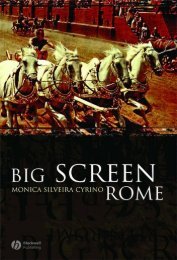Troy From Homer's Iliad to Hollywood Epic - Amazon Web Services
Troy From Homer's Iliad to Hollywood Epic - Amazon Web Services
Troy From Homer's Iliad to Hollywood Epic - Amazon Web Services
Create successful ePaper yourself
Turn your PDF publications into a flip-book with our unique Google optimized e-Paper software.
22 Manfred O. Korfmann<br />
like in the distant past. But films must show everything in detail. So a<br />
film like <strong>Troy</strong> in a way forces even archaeologists <strong>to</strong> wonder: What was<br />
<strong>Troy</strong> really like? This situation is all for the better.<br />
To professional archaeologists, ancient remains and artifacts are of<br />
chief interest as means <strong>to</strong> reconstruct the life and environment of earlier<br />
societies that emerge from an analysis and interpretation of these remains.<br />
Three general and important questions arise from this: Where do<br />
we come from, where are we <strong>to</strong>day, and where are we likely <strong>to</strong> go? In<br />
this context the metaphor of the balancing scales is instructive about<br />
past, present, and future. The more knowledge we can put in<strong>to</strong> the scale<br />
that represents the past, the more we are justified <strong>to</strong> deal with the other<br />
scale that represents the future. Of course we must also pay attention<br />
<strong>to</strong> the beam in the middle: the pivot representing our own present. But<br />
how can we reconstruct sites of ancient settlements and their geographic<br />
environs? How can we describe ancient peoples and their appearances,<br />
their daily occupations, <strong>to</strong>ols, households, workshops, palaces? To answer<br />
such questions, or at least <strong>to</strong> strive for an answer, is the archaeologists’<br />
duty, all <strong>to</strong>o often neglected. A film can remind them of this duty,<br />
even if it puts partially wrong images in<strong>to</strong> the one scale.<br />
A book recently published in German and Turkish addresses this <strong>to</strong>pic.<br />
Its title translates as follows: “<strong>Troy</strong> – How It Really Looked.” 2 We would<br />
dearly love <strong>to</strong> know how <strong>Troy</strong> really looked. The book’s authors are<br />
experts in their field, and in their introduction they acknowledge that<br />
the title more accurately should have been something like “<strong>Troy</strong> – How<br />
It Most Likely Looked According <strong>to</strong> the Best Knowledge of the Scientists<br />
Working There.” That is as close as we can get. So Petersen’s <strong>Troy</strong> can<br />
increase interest in and study of the Bronze Age and can even stimulate<br />
an archaeologist <strong>to</strong> deal with the film, as this essay shows. Both sides<br />
can fruitfully interact with each other, especially now that classical<br />
education is no longer the basis of our school curriculum. In the future,<br />
just as in the past and in the present, <strong>Troy</strong> and the Homeric landscape<br />
will be subjects of fiction and objects of research.<br />
The one question that <strong>Troy</strong> has raised again and again and that is<br />
most often addressed <strong>to</strong> me as the direc<strong>to</strong>r of excavations at Hisarlık is<br />
2 Birgit Brandau, Hartmut Schickert, and Peter Jablonka, Troia – Wie es wirklich aussah<br />
(Munich: Piper, 2004). Cf. in general the internet sites of the Troia Projekt at http://<br />
www.uni-tuebingen.de/troia and specifically Troia Virtual Reality (Troia VR) at http://<br />
www.uni-tuebingen.de/troia/vr/index_html (in English).



